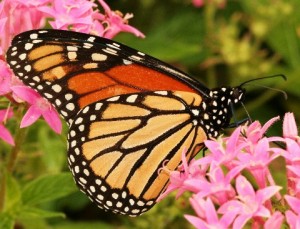12
Jun
Monarch Butterfly Decline Linked to GE Crops and Shrinking Habitat
(Beyond Pesticides, June 12, 2014) According to a new study in the Journal of Animal Ecology, the deficiency of milkweed plants due to the rapid spread of genetically engineered (GE) crops is one of the primary reasons for the decline in monarch butterflies. The widespread adoption of GE agriculture and the ever growing use of herbicides is contributing extensively to the loss of milkweed covered areas, which is the butterfly’s main food source and the only place where they lay their eggs. This study adds weight to previous reports linking GE crops, as well as climate change, to the decline of butterfly populations, which are at their lowest in two decades.
Monarch butterflies make their way from the U.S. and Canada, usually arriving in Mexico around the beginning of November, clustering by the thousands in the boughs of fir trees. Although the same trip occurs every year, no individual butterfly makes it twice, as the butterfly’s life span is too short. How the migration route lives on in the butterflies’ collective memory is an enduring scientific mystery. Researchers note that to compensate for the continued loss of habitat, refuges of milkweed must be set up to provide a source of food for butterflies. Pollinator populations have been hard hit by new farming technologies. Similar to Monarch butterflies, honey bees and other wild bees have also been experiencing a drastic decline in numbers that has been linked to the prevalent use of highly toxic herbicides and insecticides that have not been fully evaluated for their effects on insect pollinators.
Researchers from the University of Guelph have three hypotheses to explain the drop in butterflies: habitat loss in wintering grounds, habitat loss in breeding grounds in the U.S. and Canada, and harsh weather settings. They developed a model that contains migration patterns and demographic data across the monarch’s annual life cycle. Scientists looked at the single effects of each threat and compared them to the model as a whole. Lastly, they created predictions assessing the risks of habitat plant lost due to GE crops on current and future monarch butterfly population size and predicted the probability of extinction. The authors conclude that climate change and deforestation do not cause as drastic an impact on monarch population declines compared to the lack of milkweed plants on breeding grounds.
Though researchers found no conclusive evidence on what is causing the decline of milkweed, all indications point to the rise of GE soy and corn crops, and increasing herbicide use, as the most likely culprit for eradicating the milkweed. Scientists point to the prolific use of herbicides in the Midwest eliminating these plants, and found that 70% of the losses of milkweed between 1995 and 2013 were located in agricultural areas. The study affirms that the only way to help bring back the monarch butterflies is to have more milkweed plants.
In addition to widespread herbicide use and GE crops, other factors may also be leading to the displacement of milkweed habitat, including agricultural practices. With chemical-intensive agriculture, farmers use every square inch of farmland, leaving very little space for habitat for beneficials such as the monarch. One way to combat this issue is to initiate organic farming practices. Beyond Pesticides supports organic agriculture as effecting good land stewardship and a reduction in hazardous chemical exposures for workers on the farm. The pesticide reform movement, citing pesticide problems associated with chemical agriculture, from groundwater contamination and runoff to drift, views organic as the solution to a serious public health and environmental threat.
Beyond Pesticides publicizes the serious health and pest resistance problems associated with the chemical-intensive practices and provides important links to activists working to advance sustainable practices. Over 70% of all GE crops are altered to be herbicide-resistant. Increased planting of herbicide-resistant GE crops has led to a dramatic increase in herbicide use. The over use of herbicide-resistant crops has also led to “super weeds,” and the destruction of pollinator habitat.
With one in three bites of food reliant on bees and other insects for pollination, the decline of honey bees and other pollinators due to pesticides, and other man-made causes demands immediate action. For more on this and what you can do to protect pollinators, visit Beyond Pesticides’ BEE Protective webpage.
Join us next week for Pollinator Week! It provides an opportunity to show respect for the numerous benefits pollinators provide to agriculture and the environment.
All unattributed positions and opinions in this piece are those of Beyond Pesticides.
Sources: Vox , Journal of Animal Ecology










